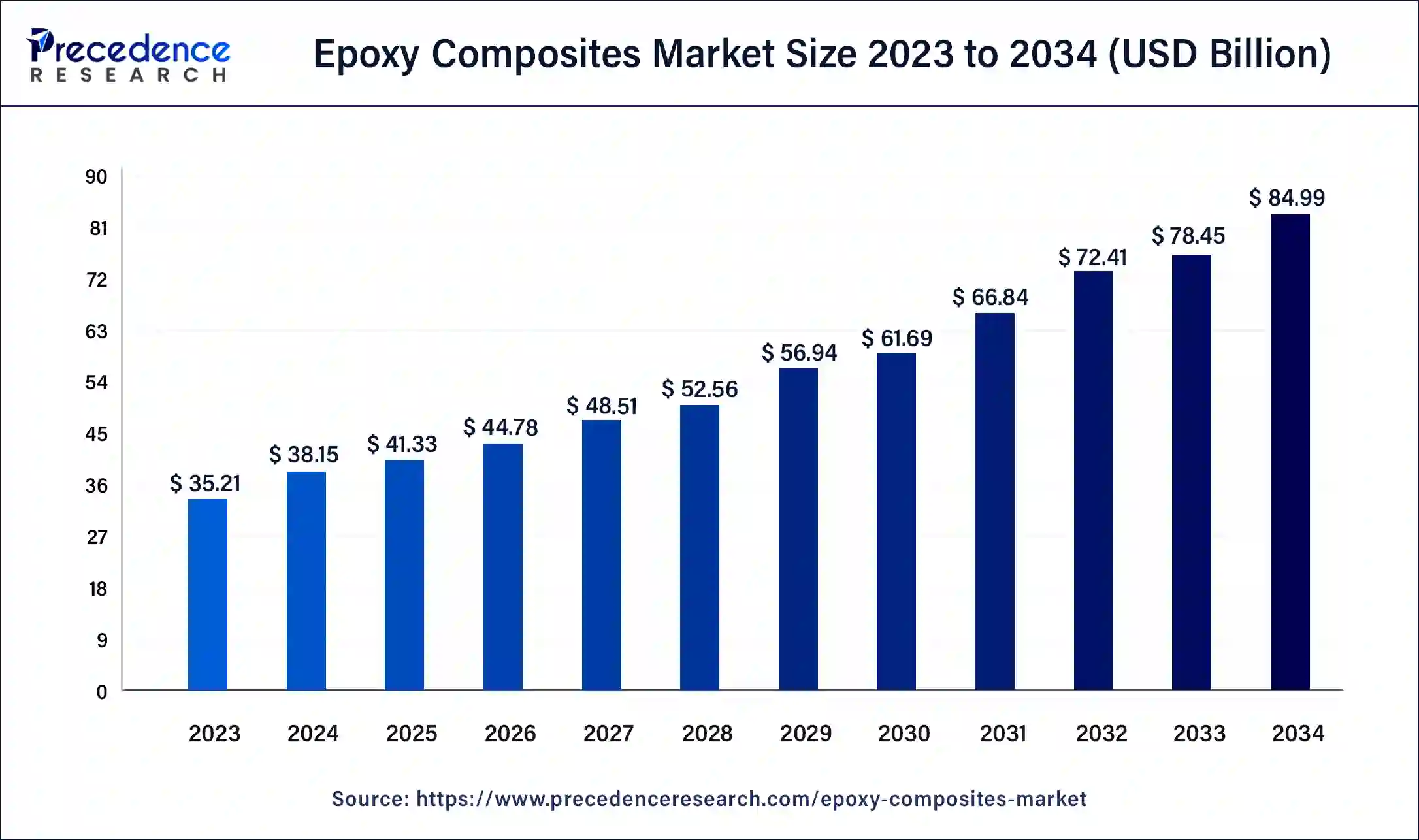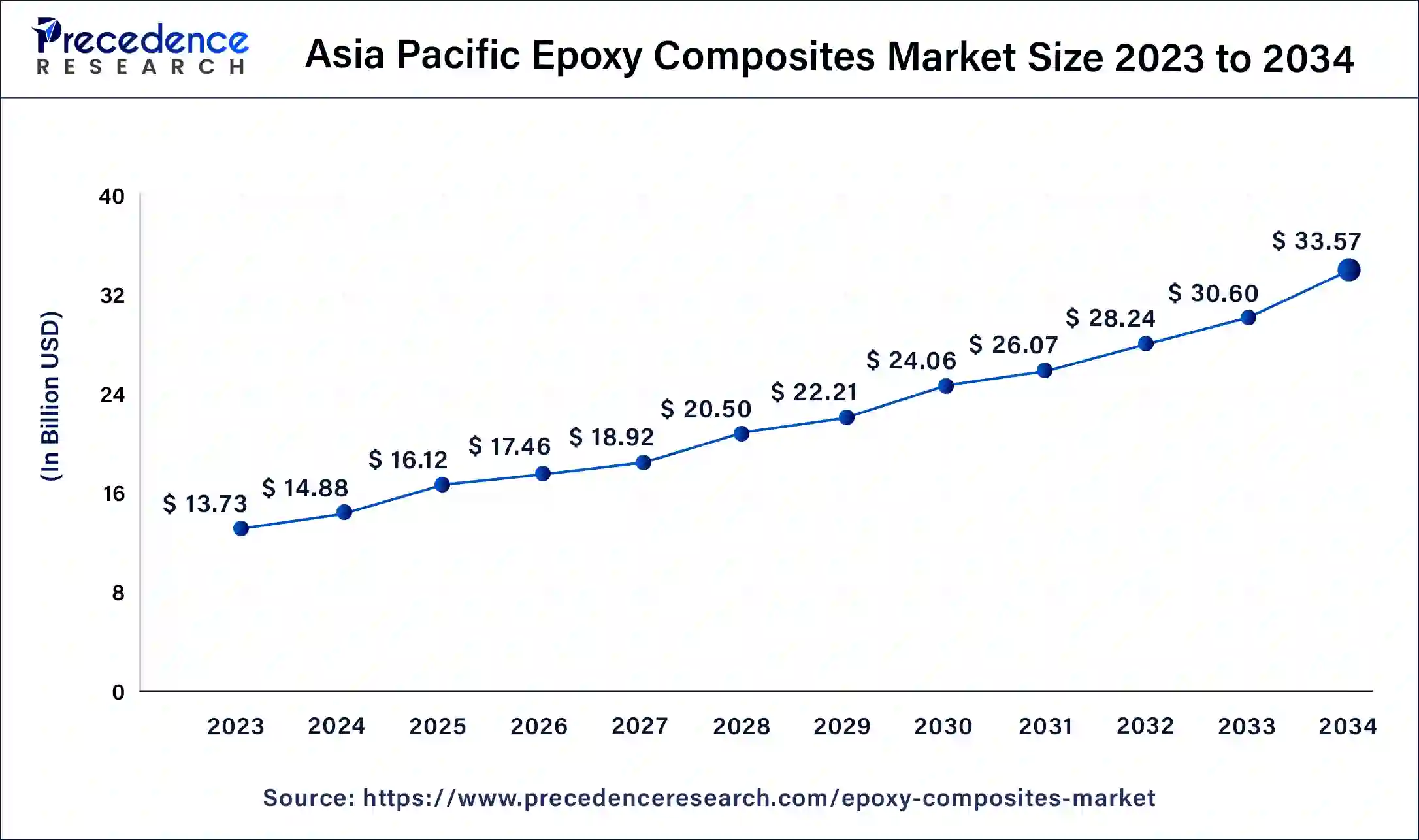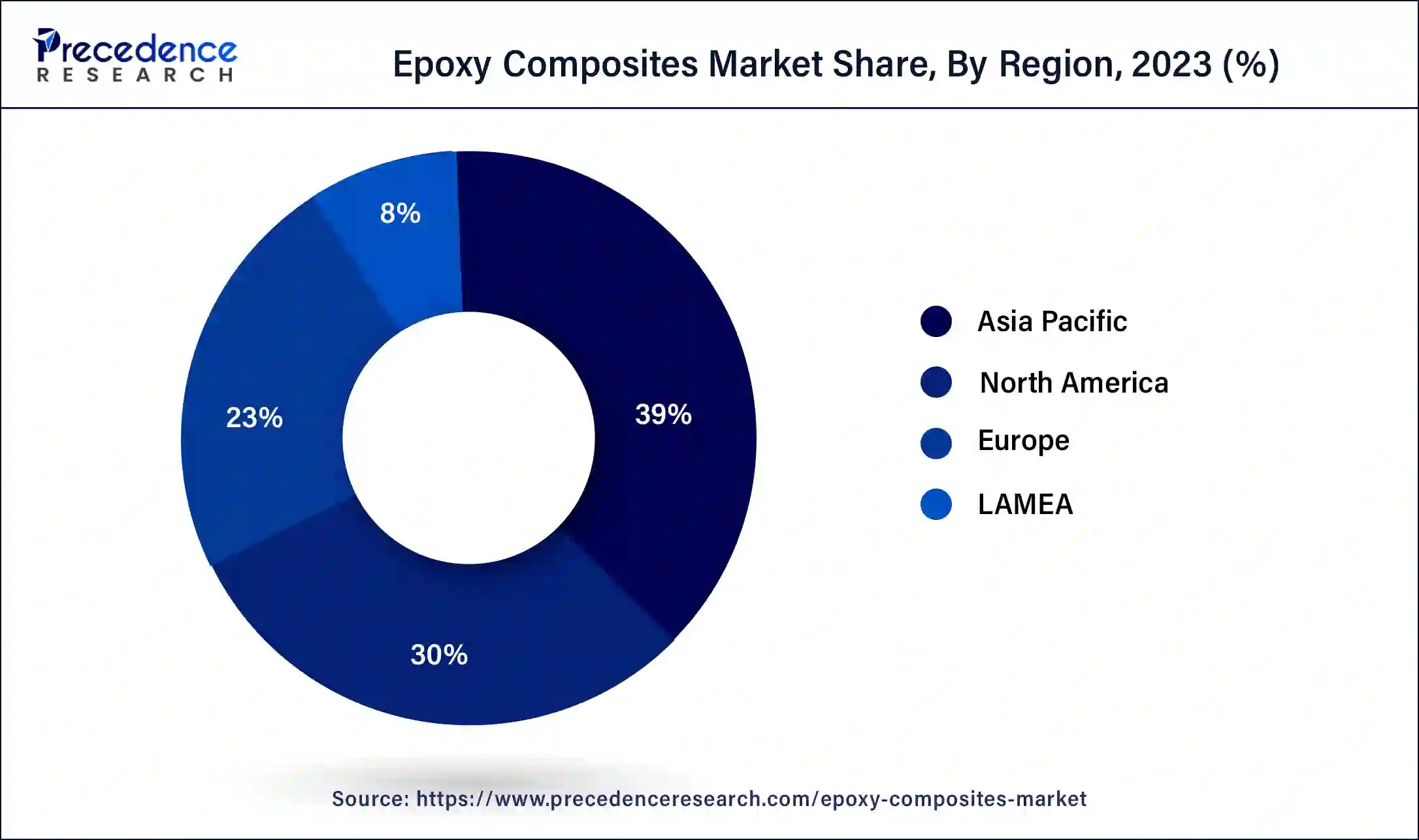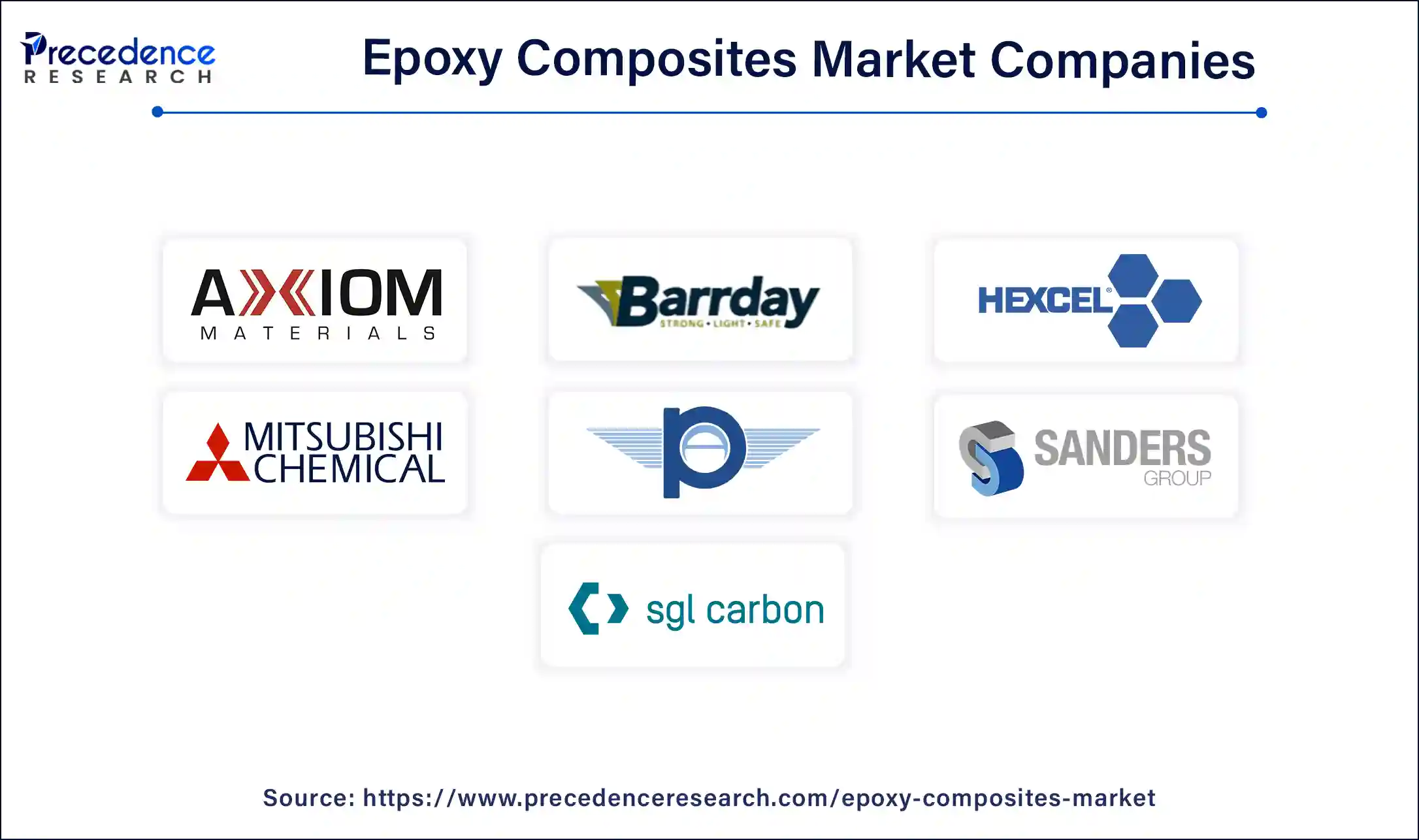March 2025
Epoxy Composites Market (By Fiber Type: Glass Fiber, Carbon Fiber, Other Fiber; By End use: Automotive & Transportation, Aerospace & Defense, Wind Energy, Electrical & Electronics, Sporting & Consumer Goods, Other End-Use (Oil & Gas, Marine, Construction)) - Global Industry Analysis, Size, Share, Growth, Trends, Regional Outlook, and Forecast 2024-2034
The global epoxy composites market size was USD 35.21 billion in 2023, calculated at USD 38.15 billion in 2024 and is expected to reach around USD 84.99 billion by 2034, expanding at a CAGR of 8.34% from 2024 to 2034. Epoxy composites are ideal for a variety of applications in the automotive and aerospace industries due to their exceptional mechanical qualities and high strength-to-weight ratios.

The Asia Pacific epoxy composites market size was exhibited at USD 13.73 billion in 2023 and is projected to be worth around USD 33.57 billion by 2034, poised to grow at a CAGR of 8.46% from 2024 to 2034.

Asia Pacific held the largest share of the epoxy composites market in 2023. The need for strong, lightweight materials like epoxy composites in a variety of industrial applications has increased due to the rapid industrialization of nations like China, India, and Japan. The market for epoxy composites is being driven by rising investments in infrastructure projects, including transportation and construction, because of its high strength-to-weight ratio and resilience to corrosion.
The epoxy composites market is being used by the Asia Pacific car sector to create lightweight components that lower emissions and increase fuel efficiency. Epoxy composites profit from the growing electronics manufacturing sector in the region and are frequently employed in electrical insulation applications and electronic components. The increasing use of renewable energy projects, such as solar panels and wind turbine blades, is driving up demand for epoxy composites because of their high mechanical strength and resilience to weathering.

North America is expected to host the fastest-growing epoxy composites market during the forecast period. The epoxy composites market is expanding in North America as a result of rising use in a number of sectors, including wind energy, construction, automotive, and aerospace. The durability, corrosion resistance, high strength-to-weight ratio, and lightweight characteristics of epoxy composites are some of the factors propelling this rise. Epoxy composites are widely used in the aerospace industry, particularly to reduce weight and increase fuel efficiency in airplane components.
Epoxy composites are utilized in automotive applications to create lightweight structural parts that improve vehicle efficiency and performance. Epoxy composites are also widely used in infrastructure projects because of their exceptional strength and resistance to environmental variables in the construction industry. All of these elements work together to support the growth of the epoxy composites market in North America.
The industry that produces, distributes, and uses composite products that use epoxy resins as their main matrix material is known as the epoxy composites market. Epoxy composites are engineered materials that are made of lightweight, robust, and long-lasting structures by combining epoxy resins with reinforcing fibers like carbon, glass, or aramid fibers. Because epoxy composites are resistant to chemicals and corrosion, they are employed in pipelines, maritime vessels, and offshore constructions in the infrastructure. Rising industrialization and infrastructure development in emerging economies are fueling demand for epoxy composites in a number of industries. Because of their superior mechanical qualities, resilience to corrosion, and adaptability in production processes, these composites are widely used in a variety of industries, including electronics, aircraft, automotive, construction, and maritime.
Since the epoxy composites market products are lightweight and have a high strength-to-weight ratio, they are frequently employed in aerospace and defense applications. Epoxy composites are being used more often in automobile manufacture to lighten vehicles, increase their fuel economy, and improve their durability. Because of their great mechanical strength, resistance to corrosion, and capacity to endure challenging climatic conditions, epoxy composites find application in the construction industry. Because epoxy composites are lightweight and have great fatigue resistance, they are widely utilized in wind turbine blades, which are becoming more and more common as wind energy projects expand globally. Because of their electrical qualities and flame-retardant nature, epoxy composites are used in electrical insulation, circuit boards, and electronic components.
| Report Coverage | Details |
| Market Size by 2034 | USD 84.99 Billion |
| Market Size in 2023 | USD 35.21 Billion |
| Market Size in 2024 | USD 38.15 Billion |
| Market Growth Rate from 2024 to 2034 | CAGR of 8.34% |
| Largest Market | Asia Pacific |
| Base Year | 2023 |
| Forecast Period | 2024 to 2034 |
| Segments Covered | Fiber Type, End-use, and Regions |
| Regions Covered | North America, Europe, Asia-Pacific, Latin America, and Middle East & Africa |
Growing demand for renewable energy
Since epoxy composites are lightweight, very durable, and resistant to corrosion, they are widely utilized in wind turbine blades. The need for cutting-edge composite materials like epoxy composites is rising along with the wind energy industry. Photovoltaic (PV) panels are made using epoxy resins, specifically for encasing solar cells. They increase the longevity and effectiveness of solar panels by offering superior adhesion and protection against environmental elements. Epoxy composites are utilized for supports, frames, and structural elements, among other infrastructure components, in renewable energy projects. The spread of renewable energy installations worldwide is supported by this application.
Limited recycling options
One major difficulty in the epoxy composites sector is the scarcity of recycling possibilities. When compared to other materials like metals or some thermoplastics, epoxy composites might be more challenging to recycle because of their intricate structure and the curing process that goes into them. The curing process epoxy resins go through to form a cross-linked structure in composites. This structure is irreversible after it has cured, making it difficult to break down and recycle the material effectively in typical circumstances. Fibers (such as carbon or glass) are usually placed in an epoxy resin matrix to form epoxy composites. The process of separating these components for recycling is difficult and frequently not profitable. Because of the possible effects on the environment, traditional disposal techniques like landfilling and incineration could not be in line with sustainability objectives.
Construction and infrastructure
Epoxy composites are used to strengthen and repair buildings, bridges, and other infrastructure, increasing the structural integrity and longevity of the structures. They are used in construction parts where strong, lightweight materials are needed, such as beams, columns, and panels. Because they are low maintenance and resistant to abrasion, epoxy composites are widely used in flooring systems and protective coatings.
Epoxy composites are utilized in infrastructure projects to make pipelines, tanks, and other industrial equipment because of their resistance to corrosion and long-term durability. Epoxy composites are essential to the production of wind turbine blades in the context of renewable energy because of their low weight and resistance to adverse environmental conditions.
The glass fiber segment held the largest share of the epoxy composites market in 2023. As reinforcement materials, glass fibers are essential in the epoxy composites market. They are frequently employed to improve the impact resistance, stiffness, and strength of epoxy composites. Glass fiber-reinforced epoxy composites find extensive application in a multitude of industries, such as electronics, automotive, aerospace, and construction. They are especially well-suited for applications where their corrosion resistance, lightweight design, and cost are favorable characteristics. Furthermore, glass fibers can be customized to satisfy certain performance needs in various market applications by using alternative weaving patterns and fiber orientations. Glass fiber composites are also used in the sports equipment, automobile, aerospace, and marine industries, which further enhances the market's expansion and adaptability.
The carbon fiber segment is expected to grow at the fastest rate in the epoxy composites market during the forecast period. Because of their excellent stiffness-to-weight ratio and high tensile strength, carbon fibers are a great choice for applications requiring lightweight materials with excellent structural integrity. Epoxy composites reinforced with carbon fibers are appropriate for demanding applications in sports equipment, automobiles, and aerospace because of their exceptional fatigue resistance and endurance.
Carbon fibers can be customized with various weaves, orientations, and surface treatments to produce desired mechanical, thermal, and electrical properties, depending on the particular application. They are widely employed in a variety of industries, including wind turbine blades for renewable energy, sports and recreation, aerospace, automotive, construction, and sports and leisure (for reinforcement and high-performance equipment). Because carbon fibers don't corrode, epoxy composites last longer and are more reliable in challenging conditions.
The automotive & transportation segment held the largest share of the epoxy composites market in 2023. The need for strong, lightweight materials is drawing a lot of attention to the automotive and transportation industries. Epoxy composites can improve overall vehicle performance and fuel efficiency since they are lighter than conventional materials like metals. These composites are ideal for structural applications in automobiles because they have high strength-to-weight ratios and superior fatigue and impact resistance.
Epoxy composites may be molded into intricate designs, enabling designers to create pieces that are visually beautiful and aerodynamic. As more automakers use these materials to meet emissions, efficiency, and performance regulations, the automotive and transportation segment of the epoxy composites market is expected to develop.
The aerospace segment is expected to grow at the fastest rate in the epoxy composites market during the forecast period. Because epoxy composites are lightweight, have a high strength-to-weight ratio, and are resistant to corrosion and fatigue, they are essential to the aerospace industry. These materials are widely utilized in the construction of fuselages, wings, empennage, and interior parts of aircraft. Epoxy composites aid in the overall weight reduction of aircraft, which is essential for performance and fuel efficiency.
The aerospace industry's market for epoxy composites is expanding as producers look for cutting-edge materials to satisfy strict legal specifications and improve aircraft performance. Aerospace engineering performance criteria and structural integrity are preserved by epoxy composites, which also contribute to total weight reduction. Their application greatly enhances aircraft performance overall and fuel efficiency.

Segment Covered in the Report
By Fiber Type
By End-use
By Geography
For inquiries regarding discounts, bulk purchases, or customization requests, please contact us at sales@precedenceresearch.com
No cookie-cutter, only authentic analysis – take the 1st step to become a Precedence Research client
March 2025
December 2024
September 2024
December 2024